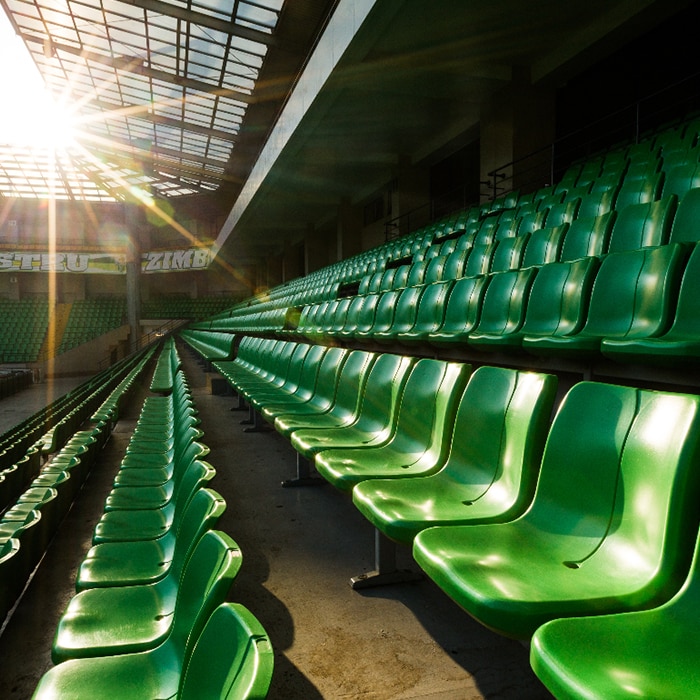Internet of Things in sports has been saved

Perspectives
Internet of Things in sports
Bringing IoT to sports analytics, player safety, and fan engagement
It’s not just about the game anymore. An increasingly digital world is forcing the sports industry to adapt, and the Internet of Things (IoT) can bridge the gap between the physical world and the digital space. Learn how IoT is changing the way in which teams operate, athletes train, and fans engage.
Explore content
- Today's IoT presence in sports
- IoT data integration in sports organizations
- IoT’s potential to transform
- IoT implementation strategy
- Get in touch
Today’s IoT presence in sports
Many organizations are utilizing IoT today in specific areas to address a particular need or challenge. Teams are focusing their IoT efforts on three main areas:
- Player development: IoT is revolutionizing the way coaches facilitate training, manage players, and address key situations in each game. Combining advanced analytics with sensors and game video, coaches can easily process vast amounts of data to obtain metrics on player efficiency, player performance, and opponent weaknesses to better develop in-game strategy.
- Player safety: IoT is shaping the way that sports physicians, physical therapists, and team doctors are reducing injuries and helping players heal faster. Embedded devices such as smart insoles and built-in chips offer real-time tracking that provides a holistic view of the athlete, allowing organizations to make the best decision for their longevity and health.
- Fan engagement: IoT is being used in smart stadiums, improving digital engagement and ultimately the in-arena experience. The stadium of the future is here, allowing fans to engage with their favorite teams and athletes like never before. Many organizations are investing billions of dollars on new stadiums and stadium improvements to focus on the fan experience to get fans off the couch and into the venue.
Current limitations: IoT data is not well-integrated in sports organizations
Although many organizations are investing in technology, they need to adapt their way of thinking quickly in order to avoid key challenges and the risk of getting left behind. Older stadiums are starting to show their age and fall behind in terms of infrastructure and technology. As the price of tickets rise and the at-home experience improves, many teams are seeing their game attendance steadily decline. Teams are gathering data on their players and fans from multiple sources, but these data sources are often not being integrated.
Currently, many teams are implementing IoT capabilities into their stadiums and organizations, but the solutions are often independent and don’t work together, preventing organizations from realizing the full potential of IoT. Unused current assets, limited wearable application, siloed fan experiences, and self-contained operational technology (OT) and IT systems contribute to organizations not being able to fully leverage IoT. Teams and organizations need to recognize the prevalence and real power that IoT can have when it’s integrated and considered on a comprehensive, holistic level.

IoT’s potential to transform organizations
IoT can transform the sports industry as it enables breakthrough results by bridging the physical and digital world in innovative ways and drives value by integrating data sources and connecting with fans through many technologies. Integrating the data gathered by different IoT sources and improving the connectivity of systems can increase venue efficiency, enhance fan experience, create additional revenue streams, and provide real-time personalization.
- Efficiency: Organizations can leverage IoT to drive venue efficiency through a number of initiatives such as traffic management, building performance, and stadium security to improve the game-day experience.
- Experience: While the field of play may still be the main focus for the majority of fans, several enhancements using IoT such as real-time statistics, social media integration, and mobile apps are changing the way fans enjoy the sport.
- Revenue: IoT also allows organizations to capitalize on the smart technologies and drive revenue in new and innovative ways.
- Personalization: IoT key enablers such as Wi-Fi, networked hardware/beacons, connected visual/display hardware, and venue-wide enterprise resource planning (ERP) can lead to detailed data analysis, allowing teams to tailor their offering to each fan’s specific needs in real-time.


IoT can be successfully implemented with a comprehensive strategy
A successful and effective IoT-driven sports organization relies on several key principles that must be considered to maximize the power and benefits of IoT:
- Think big, start small, scale fast: In order to implement an effective IoT strategy within an organization, teams should focus on laying the foundation from a technology, organizational structure, culture, and business process perspective on a holistic scale. Then expand by starting small and scaling fast.
- Harness the power of data: IoT produces mass amounts of data that organizations and teams can leverage to make better operational decisions, customize the experience for fans, construct state-of-the-art stadiums, and develop players. The data gathered from IoT sources can be a game changer for teams when used properly.
- Improve the entire fan experience: IoT allows teams to customize the experience for each fan from the moment they consider purchasing tickets through to the final whistle, and beyond. With rising ticket prices and declining sales, teams should use IoT to create a unique and unforgettable experience for fans, both inside the stadium and at home.
Sports organizations stand to benefit immensely by executing a comprehensive IoT strategy and integrated framework as technologies scale and humans become more interconnected through different mediums of technology.

Download the full report to learn how IoT can help sports organizations bridge the gap between the physical world and the digital space.
Recommendations
2024 sports industry outlook
A scouting report of five major industry trends
How data can help drive sports sponsorship and fan engagement
Upping your game



